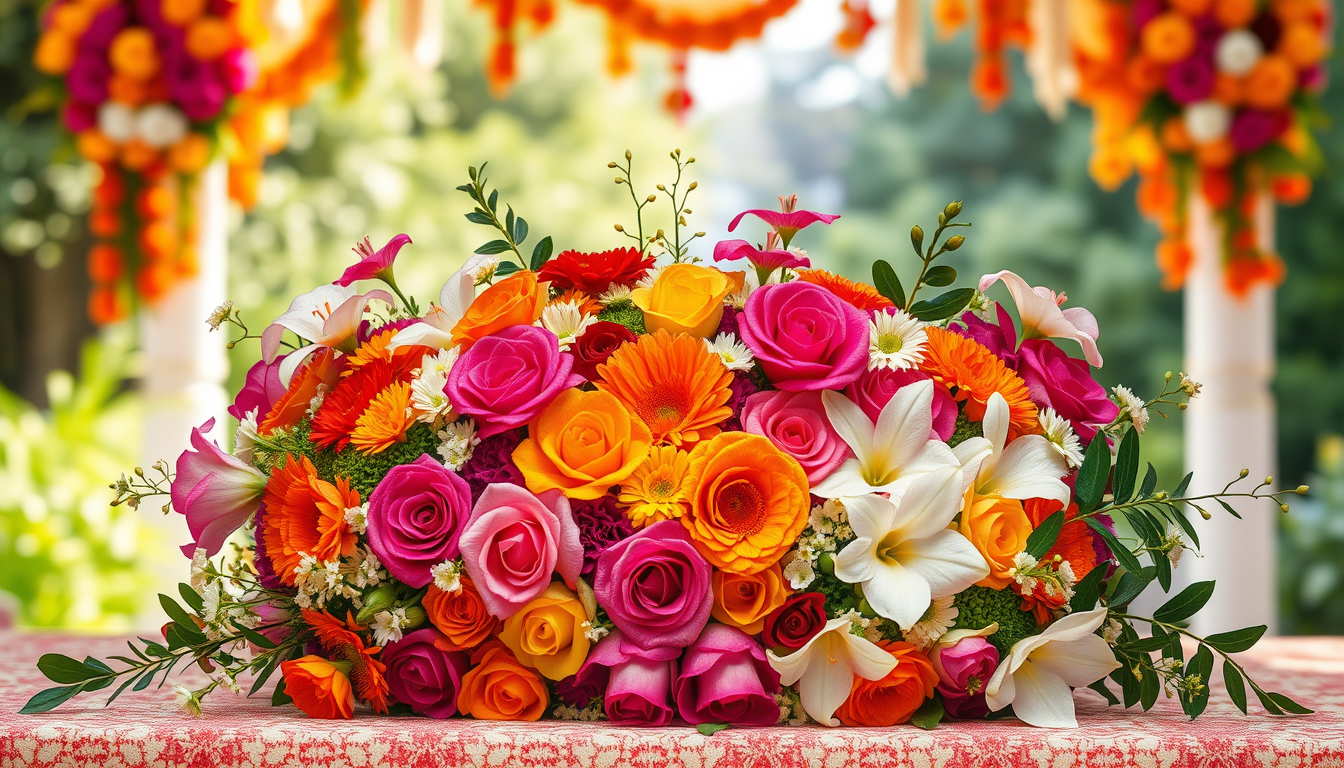Indian weddings are known for their vibrant colors, rich traditions, and elaborate decorations. One of the most significant aspects of an Indian wedding is the use of flowers. From the traditional garlands to the modern bouquets, flowers play a crucial role in enhancing the beauty and symbolism of the wedding ceremony. This guide will delve into the world of Indian wedding flowers, exploring their significance, popular choices, and how to incorporate them into your wedding.
The Significance of Flowers in Indian Weddings
Flowers have been an integral part of Indian weddings for centuries. They are not just decorative elements but hold deep cultural and symbolic significance. In Hindu weddings, for instance, flowers are believed to bring good luck, prosperity, and happiness to the newlyweds. They are also used to ward off evil spirits and negative energies.
Cultural Symbolism
Different flowers in Indian weddings hold specific meanings and symbolism:
– Marigolds (Genda): Known for their vibrant colors, marigolds symbolize love, joy, and prosperity. They are often used in garlands and decorations.
– Roses (Gulab): Roses represent love, beauty, and passion. They are commonly used in bouquets and decorations.
– Jasmine (Chameli): Jasmine is a symbol of purity, grace, and love. It is often used in hair decorations and garlands.
– Lotus (Kamal): The lotus flower symbolizes purity, enlightenment, and spiritual growth. It is often used in decorations and flower arrangements.
Popular Indian Wedding Flowers
Indian weddings offer a wide range of flowers to choose from. Here are some of the most popular choices:
Traditional Flowers
Marigolds (Genda)
Marigolds are a staple in Indian weddings. They are used in garlands, decorations, and even in the wedding mandap. The bright yellow and orange colors of marigolds symbolize happiness and prosperity.
Roses (Gulab)
Roses are another popular choice for Indian weddings. They come in various colors, each with its own meaning. Red roses symbolize love and passion, while white roses represent purity and innocence.
Jasmine (Chameli)
Jasmine is a traditional flower used in Indian weddings. It is often used in hair decorations and garlands. The sweet fragrance of jasmine is believed to bring good luck and happiness.
Lotus (Kamal)
The lotus flower is a symbol of purity and enlightenment. It is often used in decorations and flower arrangements. The lotus is also a significant flower in Hindu weddings.
Modern Flowers
Orchids
Orchids are becoming increasingly popular in modern Indian weddings. They come in a variety of colors and are often used in bouquets and centerpieces.
Peonies
Peonies are another modern flower choice. They are known for their large, round flowers and come in a range of colors. Peonies symbolize prosperity, good fortune, and happiness.
Hydrangeas
Hydrangeas are a popular choice for their unique shape and color. They are often used in bouquets and centerpieces. Hydrangeas symbolize gratitude and understanding.
Incorporating Flowers into Your Wedding
Bouquets and Garlands
Bouquets
Bouquets are a crucial part of the wedding attire. They can be made from a single type of flower or a combination of different flowers. The choice of flowers for the bouquet should reflect the bride’s personality and the overall theme of the wedding.
Garlands
Garlands are a traditional part of Indian weddings. They are often made from marigolds, roses, and jasmine. Garlands are worn by the bride, groom, and other family members during the wedding ceremony.
Decorations
Mandap Decorations
The mandap is the sacred space where the wedding ceremony takes place. It is often decorated with flowers, lights, and other decorations. Flowers are used to create a beautiful and inviting atmosphere.
Centerpieces
Centerpieces are an essential part of the wedding reception. They can be made from a variety of flowers and are often placed on tables. Centerpieces add a touch of elegance and beauty to the reception.
Hair Decorations
Hair decorations are a traditional part of Indian weddings. They are often made from flowers and are worn by the bride and other female guests. Jasmine is a popular choice for hair decorations.
Tips for Choosing Wedding Flowers
Consider the Season
The choice of flowers can depend on the season. Certain flowers are in bloom during specific times of the year. For example, roses are in season during the winter months, while jasmine is in bloom during the summer.
Choose Colors Wisely
Colors play a significant role in Indian weddings. The choice of colors should reflect the overall theme of the wedding and the personal preferences of the bride and groom. Traditional Indian weddings often use vibrant colors like red, orange, and yellow.
Work with a Florist
Working with a professional florist can help ensure that your wedding flowers are beautiful and well-organized. A good florist can provide advice on the best flowers to choose, as well as help with the logistics of delivering and setting up the flowers.
Conclusion
Indian wedding flowers are more than just decorative elements; they hold deep cultural and symbolic significance. From the traditional marigolds and roses to the modern orchids and peonies, there is a wide range of flowers to choose from. When incorporating flowers into your wedding, consider the season, choose colors wisely, and work with a professional florist to ensure that your wedding flowers are beautiful and meaningful.
By understanding the significance of flowers in Indian weddings and incorporating them into your wedding in a thoughtful and meaningful way, you can create a wedding that is not only beautiful but also rich in cultural heritage and symbolism.
